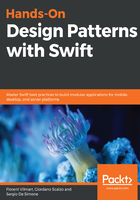
Working with ranges
Ranges come in two flavors: Range and ClosedRange. The difference between Range and ClosedRange is the inclusion of the upper bound. In a ClosedRange, the upper bound is included; in Range, it isn't.
If you want to include all numbers between 0 and 10, not including 10, you can represent it in two ways, as follows:
let range1 = 0..<10
let range2 = 0...9
range1.contains(10) // false
The two ranges are equivalent, and they contain the same numbers. They read differently and carry different meanings, however depending on what you want to express, you may want to pick one over the other. Ranges work with the Comparable protocol, which means that any type that conforms to this Comparable protocol is suited for creating ranges.
For example, you could create a Range type of Strings, as follows:
let uppercased = "A"..."Z"
uppercased.contains("C") // true
uppercased.contains("c") // false
You can also use the ~= operator, which is an alias for the contains method:
uppercased ~= "Z" // true